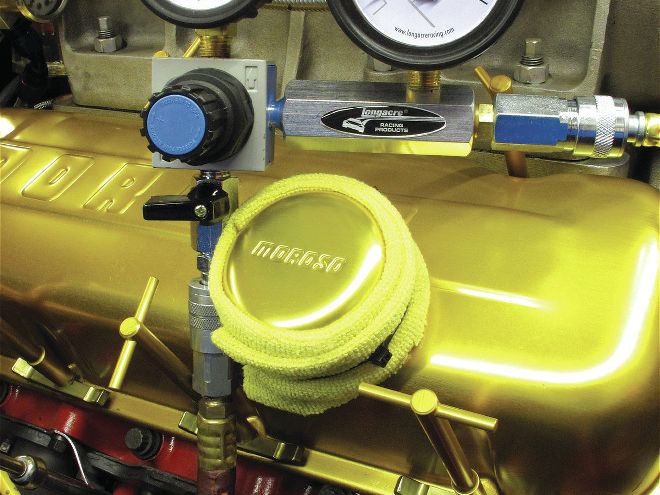
Spend a little cash on a leakdown tester and you could save a lot of time, money, and headache the next time you are purchasing an engine with an unknown history or debating whether to tear down one you already have. A leakdown tester threads into a spark plug hole, pressurizes the cylinder with compressed air, and then determines what percentage of the air going into the cylinder is leaking out of it. Leakdown normally occurs in the cylinder when combustion gases work their way past the piston rings, but the problem can also be valves that don't seat properly, a cracked block or head, or a bum head gasket. The leaks reduce cylinder pressure, which reduces the power output of the engine, and potentially contaminate the oil and coolant.
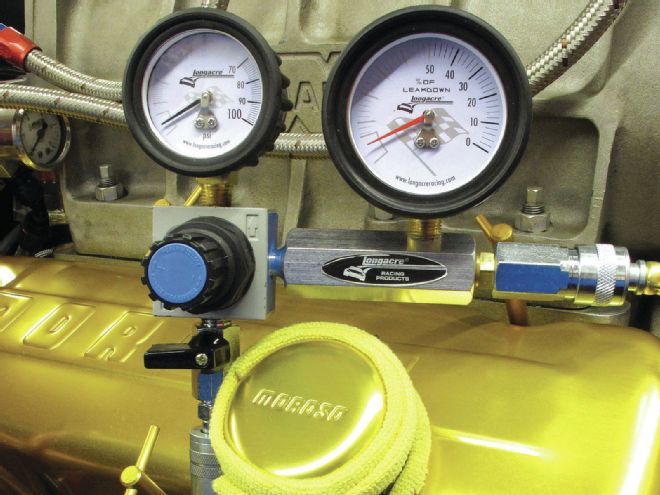 Boosted engines like the big-block in the Crusher Camaro are more likely to suffer from detonation than naturally aspirated powerplants, and detonation can kill the tension of the piston rings. A leakdown tester quickly verifies engine performance before a costly trip to the racetrack.
Boosted engines like the big-block in the Crusher Camaro are more likely to suffer from detonation than naturally aspirated powerplants, and detonation can kill the tension of the piston rings. A leakdown tester quickly verifies engine performance before a costly trip to the racetrack.
These issues can be identified with a leakdown tester, and to show you that you don't have to be a pro to take advantage of one, we picked five different testers from SummitRacing.com and used them all on the same engine to see how close the results were.
Summit Racing's private label tester was the least expensive of the bunch (PN SUM-900010, $72.95) and included adapters for 14mm and 18mm spark plug threads. It did not come with an air-source quick-disconnect fitting. Proform Parts' tester (PN 66839, $74.95) had the same adapters and also required us to add the quick-disconnect fitting. Longacre Racing Products' tool (PN LON73010, $95.95) also needed an air-inlet fitting added to it, but it came with durable, rubber-isolated gauges and a handy on/off valve for the air inlet. OTC (PN 5609, $99.05) gave us a lot of bang for our buck with 10, 12, 14, and 18mm spark plug adapters, rubber-isolated gauges, quick-disconnect fittings for the air supply and outlet hose, and a hard-plastic storage case. Finally, we grabbed one of Moroso's budget tools (PN MOR-89600, $108.95), which included 14 and 18mm plug adapters but not the quick-disconnect fitting. All the prices quoted are from SummitRacing.com.
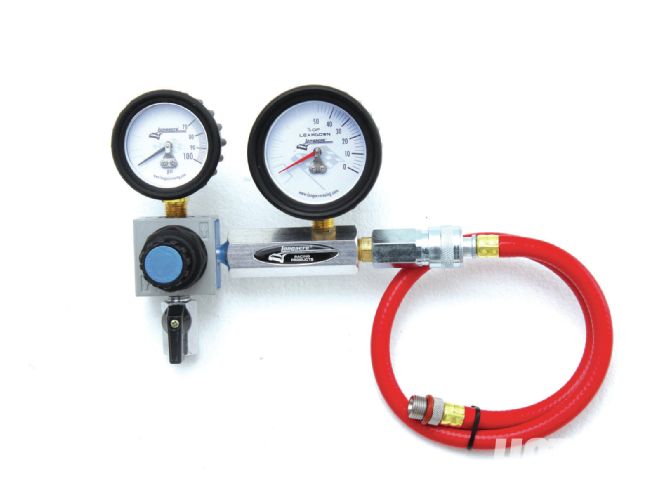 Longacre Racing's tester was the only one to feature an on/off valve (arrow) for the air-inlet connection, which was handy when disconnecting the tool from the engine.
Longacre Racing's tester was the only one to feature an on/off valve (arrow) for the air-inlet connection, which was handy when disconnecting the tool from the engine.
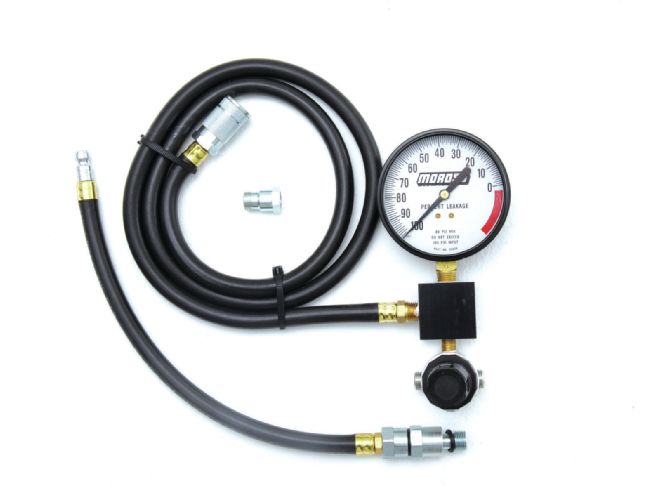 Moroso sells a variant of this budget-minded tester that has a hard case and costs a lot more dough.
Moroso sells a variant of this budget-minded tester that has a hard case and costs a lot more dough.
To keep things fair, we installed all the testers into the same cylinder of a fresh, unfired small-block Ford engine, making sure the piston was held firmly in place in the cylinder so it couldn't move and alter the leakdown readings. Our Snap-on air compressor kept a constant, 100-psi feed going to each tester. We zeroed each tool according to the specific manufacturer's instructions and then connected it to the cylinder several times, making sure the tool was recalibrated before each test.
Because we have no set standard with which to gauge each tool (other than a fresh engine with rings that are not seated to the cylinder walls), we are simply looking at the results as a whole, noting any reading that is abnormal when compared with the group. The Longacre Racing tool indicated our cylinder had 20 percent leakdown, the OTC unit said 21 percent, and the Moroso read 24 percent. Both the Proform and Summit Racing testers said the cylinder had 30 percent leakdown.
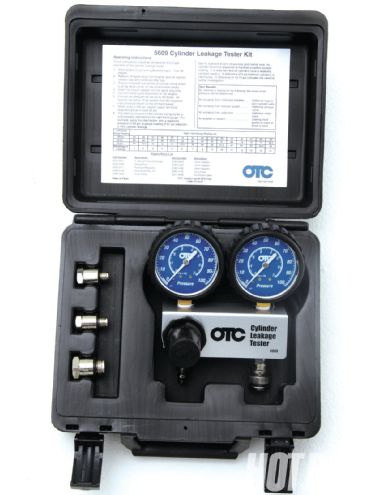 OTC provided the only tester with a protective case and everything we needed (except the air compressor) to perform a leakdown test.
OTC provided the only tester with a protective case and everything we needed (except the air compressor) to perform a leakdown test.
An interesting note is that the Proform tool was the only one that didn't require us to calibrate it to a specific inlet pressure number. Its gauge had a "set" position between 0 and 10 psi. Altering the inlet pressure influenced the leakdown results by 5 percent. At zero psi we saw 26 percent leakdown. At 10 psi we saw just over 30 percent leakdown. Which is correct? Your guess is as good as ours.
If you plan to purchase a leakdown tester to keep tabs on a fresh engine, it doesn't matter which one you choose. Get a baseline reading, keep the tool in good condition by not dropping it or exposing it to dirt or moisture, and then the only thing that matters is how much the reading changes over time as the engine wears. But if you are buying a tool to play detective with an unknown engine, you might want to consider choosing one of the testers with the lower readings. The higher-percentage numbers from the Proform and Summit tools should be considered, because you may pass on an otherwise good engine or tear one apart that might not need the attention based on the high reading. No matter which one you choose, the key to a successful reading is making sure the piston is at TDC and that both the intake and exhaust valves are fully closed.
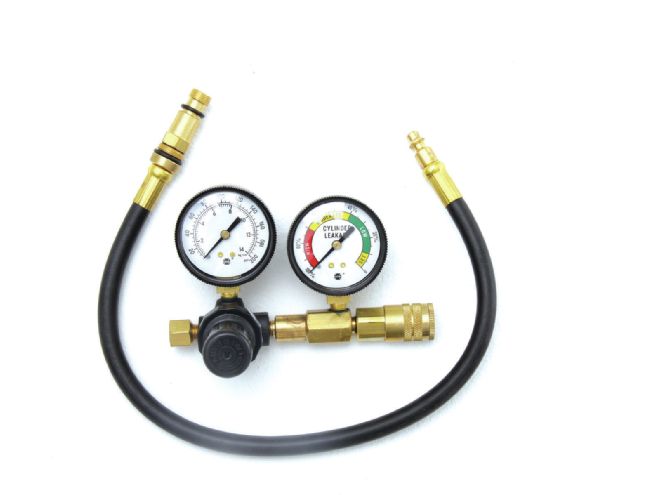 Proform Parts’ tester had an interesting quirk: A set range for the input pressure, which influenced the test results by 5 or more percentage points depending on where it was set.
Proform Parts’ tester had an interesting quirk: A set range for the input pressure, which influenced the test results by 5 or more percentage points depending on where it was set.
What Do The Numbers Really Mean?
A small percentage of leakage is normal in a properly broken-in, naturally aspirated engine with small ring-end gaps (0.015 to 0.022 inch) and a good valve job; 5 to 10 percent is acceptable. A forced-induction engine (especially one with large bores) will require larger end gaps (0.020 to 0.035 inch), so increased leakage between the rings and crankcase in the neighborhood of 10 to 20 percent is common. Once the tester reveals 25 percent or more leakdown, you have to question the condition of the engine or the validity of your test.
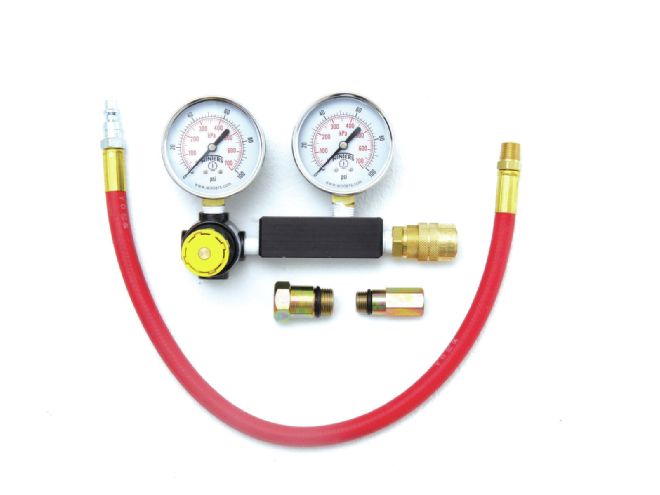 Summit Racing’s tester offered repeatable numbers, albeit ones that were several percentage points higher than the others.
Summit Racing’s tester offered repeatable numbers, albeit ones that were several percentage points higher than the others.
Of course, there are a few factors that can influence the outcome of the test, such as a questionable air supply, engine temperature, a piston moving up or down in the bore, or carbon buildup on the valve seats that prevent the valves from closing completely. Keep this in mind when using any tester, as a high reading can be attributed to a sticky valve rather than a worn-out set of rings or a bad hone job. A quick tap on the rocker arms with a rubber mallet usually improves the results.
You can also listen for leaks if you think there's a problem with the engine. If you hear air leaking through the carburetor or intake manifold, the intake valve is not sealing. The same goes for the exhaust: Noise in the pipes means a leaking exhaust valve. And if you connect the tester to one cylinder and hear air coming out of the exhaust port next to it, you can assume the head gasket is leaking. Bubbles in the coolant inside the water neck or radiator are indicative of a leaking block, cracked head, or blown gasket.
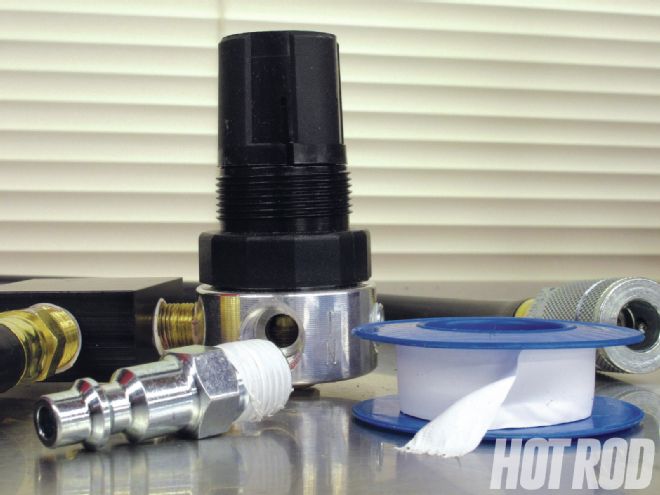 Except for the OTC unit, all the brands tested required a quick-disconnect air-inlet fitting, which wasn't provided.
Except for the OTC unit, all the brands tested required a quick-disconnect air-inlet fitting, which wasn't provided.